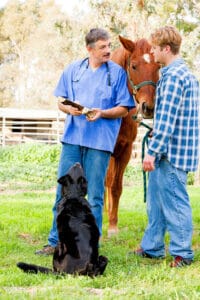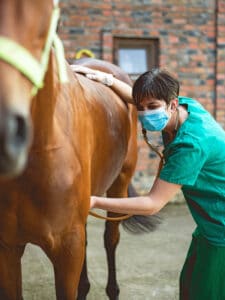It’s something of a shock to learn that vets have between two to four times the average rate of suicide. AMANDA MAC spoke to AVA President Dr Warwick Vale about this concerning issue.
To learn that among professional occupations, veterinarians are overrepresented in suicide statistics globally is bad enough. To then discover that suicide rates for Australian vets are some of the highest in the world is deeply disturbing.
Dr Warwick Vale, President of the Australian Veterinarian Association (AVA) is blunt in his assessment: “At the moment it’s at a crisis level, there’s no doubt about it. Practically speaking, we believe that in Australia we’re seeing a veterinarian suicide death every 12 weeks.”
Not all deaths by suicide are reported as such, so accessing verifiably accurate data isn’t always easy. However, based on existing figures, veterinarians were the only professional group to be singled out as being at-risk during a recent Australian Government suicide forum.

One of the reasons equine vets stay in the sector is their love of horses and horse work
You may be wondering whether this is a recent phenomenon, but Warwick says that’s not the case: “Some of the earliest research that began to identify the statistics and raise concerns was around 2009. We started to realise that we had an issue with suicide and with mental health problems. So it’s long standing and that’s a worldwide trend as well.”
A study examining the reasons why equine vets either stay in, or leave the profession was recently commissioned by Equine Veterinarian Australia, an AVA special interest group. The multi-institutional study, led by Murdoch University in collaboration with the Universities of Queensland and Adelaide, identified a variety of factors impacting the profession. On the plus side, the love of horses and horse work, challenges and accomplishment, continual learning and social purpose (the ability to make a difference) were all a source of considerable satisfaction.
But on the down side, the list of ills is worrying:
-
- Financial difficulties – vets graduate with significant educational debt, are the third lowest paid profession one year post graduation, and the lowest paid three years post graduation. Recent data from a graduate outcomes survey shows that in contrast to medicine, dentistry and engineering, studying veterinary science leads to low income earnings.
- Not feeling valued – with contributing factors such as lack of support, difficult client relationships, and difficult relationships with colleagues.
- Challenging work conditions, including long hours and after hour requirements.
- Negative impacts on mental well-being, such as chronic stress, burnout and poor work/life balance.
So where do these issues start? Could the demands of the veterinary science curriculum be undermining the mental health of undergraduates? Warwick confirms that there is evidence to suggest students are suffering increased levels of stress and anxiety. “But we’re not sure why that is. Universities have responded to the challenges to graduate and early career veterinarian mental health by offering resilience training, mental health training, and professional career life topics. They’ve made a range of outside resources available to help educate students on how to maintain their mental health and well-being.”
However, the success of these interventions is hard to determine: “We don’t seem to be getting the results we’d like to see,” Warwick notes. “We haven’t had a significant drop in the suicide rate for a couple of decades now. That said, it could be that we may actually be lessening the rate of suicide, that it might be even higher without those resources.”

Unfortunately, despite a vets best effort, not all client relationships are positive
But here’s another layer to the puzzle that Warwick has identified as a threat: “The profession is toxic to some individuals, and some workplace conditions are toxic. So no matter how much you prepare students at university, it unfortunately does little to prevent that toxicity from potentially creating mental health problems.”
And it’s not just the workplace that’s at fault, social media and the attitude of some clients also have a lot to answer for. “The age of social media has produced significant challenges for veterinarians. Bullying, trolling, abuse, aggression, those types of things in the public domain on social media sites like Facebook are definitely a factor,” Warwick tells me. “Research is showing us that these behaviours, which we didn’t see prior to the rise of social media, are having a significant impost and negative effect on veterinarians’ mental health.”
Much of this client vitriol has to do with the perception that vets overcharge for their services, a dissatisfaction that’s further fuelled if the client cannot afford the treatment their animal needs. “They shift the responsibility for the welfare of their animals onto veterinarians. They expect us to do the work for nothing or at a discounted price because we love animals,” Warwick says. “One of the most painful comments we hear is ‘you’re supposed to love animals and all you love is money’. We often get that from disgruntled clients who are confronted with economic challenges when their animals require treatment.”
Words like those cut deep – particularly when you consider many veterinarians enter the profession with $200,000 to $300,000 in student debts. Most practices can only afford to pay between $70,000 and $85,000 for a veterinarian, but that’s for someone with two to three years’ experience. New graduates usually get less, so servicing their debt is almost impossible.
And the figures don’t add up for veterinarians who set up their own practices either. “Your average salary is not much more than if you were an employee because you’ve got massive infrastructure costs,” Warwick explains. “We don’t get subsidised to buy our x-ray machines, or our ultrasounds, or our surgical equipment, or laboratory equipment, and unlike a GP who will usually send you off to the appropriate facility or to a specialist, we have to have all that equipment on hand. And the financial investment is in the millions of dollars. Setting up even a small practice would be upwards of $2,000,000.”

Achieving a veterinary science degree is a lengthy, demanding and expensive process
Clearly the frustration, despondency and burnout experienced by many veterinarians can’t all be slated back to unappreciative clients, something of which Warwick is well aware: “As a profession we have to change a lot of things about how we run our businesses. Employing a veterinarian and expecting them to be on call every other weekend, or for 24 hours at a time, or every third weekend with every third night on call – which is a very common thing for a horse veterinarian – those type of work practices are going to have to change because they’re just not sustainable.”
And as if all of that wasn’t enough, another aspect to this already troubling scenario is the issue of workplace injury. Although small practice injuries, getting bitten by dogs and cats for example, is not uncommon, equine veterinarians are particularly vulnerable. “There have been some studies done in Britain and Australia over the past couple of years that show large animal veterinarians, and equine veterinarians in particular, have one of the highest rates of workplace injuries, making it one of the most dangerous professions, or most dangerous jobs actually, in the world to undertake,” Warwick explains.
This significantly increased incidence of injury, both minor and serious enough to warrant hospitalisation, is hardly likely to improve anyone’s anxiety levels. “I’m not sure that the profession as a whole or the community really understand the physical toll that working with larger animals, particularly horses, takes,” he says. “There are very high rates of major injuries, including fractures, facial fractures, and severe open traumas. And that’s another reason why we struggle to recruit and retain equine veterinarians. Many veterinarians just find it too dangerous. They’ve been injured and they drop out.”
While Warwick is not aware of any specific research into the possible correlation between injury and mental health issues, anecdotally, it wouldn’t surprise him: “I know a lot of colleagues who’ve had their careers cut short because of injury. And most of them were very focussed, it was their passion. So when they can no longer do the work they love, that really is quite distressing for them.”
Warwick certainly doesn’t shy away from acknowledging that there’s much to be done in the workplace to help reduce the stress, depression, and anxiety many veterinarians are subject to, but he also has an important take home message for animal owners: “The community has a role in better understanding the pressures, constraints, and the business model that veterinarians work within. We’re not making mega bucks out of treating your animals. In some cases we’re barely recovering our costs.”
And whether or not these shifts in perception are achieved might well have outcomes for the future of a sustainable veterinary service in Australia. “People need to work with us and not against us,” Warwick says. “We need support, understanding, a lot less abuse, and a little bit more empathy. That would be something the community should start thinking about.”
If this article has raised issues for you, or for someone you know, contact Lifeline on 13 11 14, or Beyond Blue on 1300 22 4636 (both services are 24/7).



